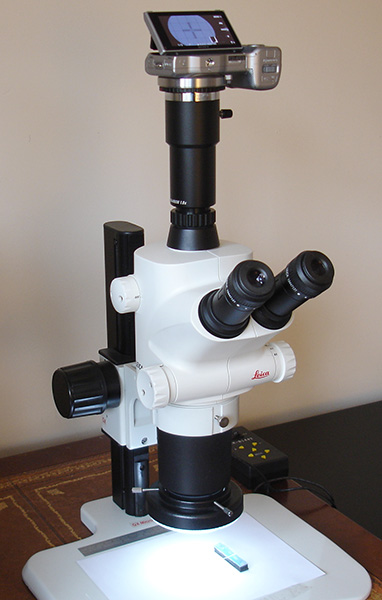
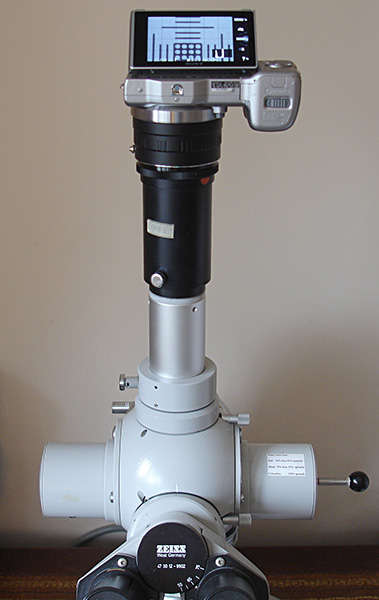
|
Notes on the potential vibration problems observed with two mirrorless digital cameras if used for photomicroscopy by David Walker, UK |
In Explorer browser, setting 'Shrink to Fit' in 'Print Preview' prints out on 7 sheets of A4 paper.
The removable lens mirrorless camera has become a popular consumer digital camera and include those based on the 4/3rds sensor by Panasonic / Olympus and on the APS sensor by Sony. Their lack of mirror removes at least one potential source of vibration if used for photomicroscopy.
However, my brother and I have found marked vibration problems with two mirrorless cameras coupled to our microscopes, a Panasonic GF2 and Sony NEX-3 if shutter speeds are not kept within strict ranges. This included work even at low power on stereos. Other users of some mirrorless models, have also reported in online forums and privately of vibration problems, especially if directly coupled to the microscope. The limitations these cameras placed on allowable mag / shutter speeds were more restrictive than when I used the scopes with a Nikon reflex mirror DSLRs without mirror lock (but 1 second shutter delay).
By inspection, the sequence when taking an exposure for the above two models is given below. Some other mirrorless models have a similar action:
Whether this double shutter action at the start of exposure causes noticeable vibration problems will of course depend on many factors including operating environment, camera model, microscope, magnification, exposure and how camera supported. Decoupling the camera on a sturdy external support is one approach to minimise vibration, although such a support can often be impractical especially for large research microscopes or for where desk space is limited (see Footnote 1).
Enter 'EFCS': Some recent mirrorless cameras e.g. the Sony NEX-5N, -5R, -6 and -7, now offer an electronic first curtain shutter option (popularly abbreviated 'EFCS'). As the name suggests, there is no mechanical 'cocking' of the shutter at exposure start and with the absence of a mirror, gives exposures essentially free of camera sourced vibration at any shutter speed —an ideal feature for macroscopy, microscopy and astronomy.
The video above shows the Sony NEX-5N with 'front curtain shutter' off, i.e. set to operate as a camera without this option such as the Sony NEX -3, NEX-5 and many of the Panasonic and Olympus range of mirrorless cameras. A 4 sec. exposure, which starts when beep / light stops.
The shutter has a close / open cycle at start of exposure and uses a mechanical front curtain shutter during exposure and a double shutter action at end to leave sensor exposed again. (Turn PC sound on to better follow shutter sequence.)
EFCS is already a well established feature on some Canon DSLRs and Sony SLT models (the latter with translucent fixed mirror). Michael Hohner's article 'Electronic Front Curtain Shutters' provides an animation of a typical mechanical focal plane shutter and discusses how a camera's EFCS feature affects the exposure cycle and shutter design.
The noted photomicrographer Charles Krebs in his informative article 'Canon "Live View" with electronic first shutter curtain' clearly illustrates the feature's potential value for photomicroscopy in Live View mode where camera sourced vibration from mirror or shutter is essentially eliminated. After confirmation with Canon, Charles lists at the time of his writing, the Canon DSLRs with 'fixed' EFCS and those with it as an option (the 'Silent Mode'). By inspection of the shutter cycle, EFCS is a fixed feature on my own Canon 600D.
My brother Ian now owns a Sony NEX-5N which offered an opportunity to assess any vibration problems with and without 'EFCS' activated on this mirrorless camera. A summary of these studies is shown below for my Zeiss Photomicroscope III and Leica S series stereo microscope. Earlier problems with a Panasonic GF2 without this feature are also summarised as well as an illustration of how important the test object chosen can be if vibration is primarily on one axis.
Note: I'm fortunate to live in a house with no external or internal sources of potential vibration. The microscopes are on a sturdy typical writing desk without any special microscope isolation from desk / floor. Although a suspended upper floor, standing away from the microscope after activating camera's 10 second self timer removes any user vibration problems. So the microscope studies are essentially testing the camera sourced vibrations.
The video above shows the Sony NEX 5N with 'front curtain shutter' on, 4 sec. exposure, which starts when beep / light stops.
The exposure starts without any mechanical shutter action and an electronic first curtain is used during the exposure; only at the exposure end is there any mechanical movement, i.e. when shutter closes/reopen. (Turn PC sound on to better follow shutter sequence.)


Sony NEX-5N body only shown on a Leica S series stereo (connected via a NEX to C mount adapter) and a Zeiss Photomicroscope III (connected via a NEX to Nikon bayonet adapter to a conventional third party 35 mm film photomicro' adapter). The couplings for both use commercial adaptors, are very sturdy and have been carefully shimmed where needed to remove any last trace of detectable lateral or rotational flex.
In their excellent manual 'Photomicrography with 35 mm SLR Cameras' dated 1999, Zeiss advise a user to take a series of test exposures with suitable high contrast subjects (e.g. micrometer slide) for all likely combinations of shutter speed and optical mag to critically assess if vibration occurs and for what speeds. This remains excellent advice in the digital age to assess an unfamiliar digital camera photomicroscopy system. (In the tests either the ISO and/or illumination level were used to set the shutter speed at desired setting.)
Panasonic GF2 (with micro 4/3rds sensor) on Leica stereo, and how an unsuitable test subject can mislead:
Ian and I no longer have this camera, but did study the vibration across a range of shutter speeds using micrometer slides. The images below of two types of slide were take at 1/125th sec where vibration was at a maximum. The vibration was predominantly along the y axis i.e. the same plane as the shutter movement and illustrates that test slides with clear detail in both x and y axes are needed to reveal any loss of detail.
|
Optical zoom 8x. Full field in 1:1 format mode of camera using 0.1 mm horizontal scale micrometer slide, shutter 1/125th sec. This slide does not clearly show that there is quite marked vibration present because the majority of the vibration is on the y axis.
Above, crop of master of 0.1 mm slide image more readily shows the vibration in y plane but a slide with linear detail along x and y axis is better.
Right: Unresized crop of master image of the 0.01 mm Motic slide shows the vibration more clearly along y axis. For large web images, prints or crops this could give a marked loss of subject detail and/or micro contrast. A control image taken with electronic flash, not shown, revealed that softening along x axis was also vibration sourced. |
Optical zoom 8X. Motic 0.01 mm slide with x-y scales occupies ca. 2/3rd of camera field but even at this image size, clearly shows the loss of detail in y direction.
|
Panasonic GF2 camera on Leica S stereo 1-8X zoom - vibration tests summary
The GF2 does not have an EFCS feature and a summary of the tests are shown in the table below for the two mag extremes. At 8X (and likely some mid range mags) a large range of common shutter speeds for typical lighting and low ISO were unusable. Working outside a typical speed range could be awkward for moving subjects or if using a low ISO for least noise. (Green are vibration free speeds, red for speeds where vibration unacceptable.)
|
Usable |
Unusable |
Usable |
|
| 1.6X optical zoom set |
Not tested |
Not tested |
1/100th OK |
| 8x optical zoom set |
1/4 or slower |
ca. 1/2 - 1/250th |
1/500th or faster |
(The photo port on the Leica does not use an eyepiece but final mag matches a ca. 10X eyepiece for visual studies, i.e. ca. 10-80X total optical mag range.)
Sony NEX-5N with APS-C sensor and optional EFCS on a Leica S series stereo and Zeiss Photomicroscope III
A summary of the acceptable speeds for the Sony NEX-5N on the Leica S stereo and Zeiss Photomicroscope III are shown below using the cross-hair micrometer slide. To highlight any potential vibration on the Photomicroscope, the Optovar was set at 2X. Some typical images are shown below the tables.
A large range of shutter speeds at medium to higher mags on the compound and highest zoom on the stereo were not usable which made practices such as keeping the illumination level constant for given white balance, tricky. The usable range were those with barely detectable vibration and was subtle at the 'unusable' extremes but still noticeable cf EFCS mode if seeking large prints or image crops.
The modern Leica S models have a sturdy oval section focussing support but uses wide plastic rack and pinion gearing, which is common in their range from basic to advanced. The height of the optics system supported in a single ring clamp are perhaps more prone to residual vibration transfer than more compact optical heads with traditional metal rack and pinion designs.
Leica S stereo
|
Usable |
Unusable |
Usable |
|
| 1-2X optical zoom set, EFCS off |
|
|
1/125th OK |
| 8x optical zoom set, EFCS off |
2 sec or slower |
1 - 1/800th |
ca. 1/1000th or greater |
| 1 - 8X, EFCS on |
No detectable vibration at any speeds, cf flash control |
Zeiss Photomicroscope III (Optivar 2x, projection eyepiece 10X)
|
Usable |
Unusable |
Usable |
|
| Objective 16X, EFCS off |
1/125th at least |
||
| Objective 40x, EFCS off |
1/2 or slower |
ca. 1/4 to 1/250th |
1/500th or faster |
| EFCS on, any objective, including 100x (total optical mag approaching 2500X) |
Either no detectable (or at 2500X, significant) vibration at any speeds, cf flash control |
Sony NEX-5N on Leica S stereo
|
Above: Optical zoom 8X, EFCS off, 1/80th sec. Even this fuller field view shows marked softness and images would be unusable. As for the GF2, vibration was most marked in the ca. 1/75th - 1/125th range. |
Above, crop of image left. Vibration is severe, although curiously, more so along the x axis i.e. at right angles to the shutter movement (in contrast to the Panasonic GF2). The stereo scope support is a single screw clamp on a ring with any residual vibration likely along the x axis. |
Sony NEX-5N on Zeiss Photomicroscope III, Optovar 2X, medium power objective
|
Above: Objective 16X, EFCS off, 1/125th sec. At this modest objective mag there is already image softening, primarily on the y axis, the same as the shutter travel. On my previous Nikon budget reflex mirror DSLRs without mirror lock, but 1 sec shutter delay, I could use any shutter speed for the 16X objective and below on the same camera couplings. |
Above, as for image left but with EFCS on. |
Sony NEX-5N on Zeiss Photomicroscope III - extreme test of EFCS with highest power objective and 2X Optovar
|
Above: Objective 100X, EFCS on, 1/125th sec. This total optical mag of 2500X is not likely to be used, but an extreme test for EFCS with tungsten lighting at 1/125th i.e. the worst speed without EFCS. There is a slight vibration softening (possibly external factors contributing at this extreme).
|
Above, as for image left with EFCS on, but using electronic flash to give a vibration free control comparison. |
Example of the effect of residual vibration on stereo with Sony NEX-5N at 2X optical zoom
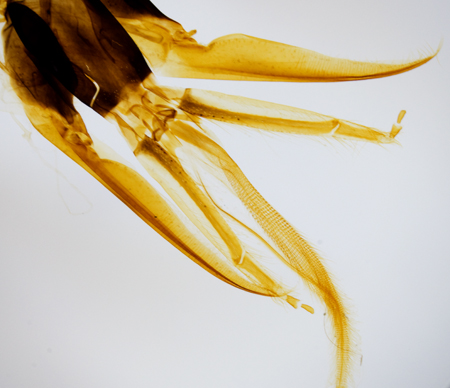
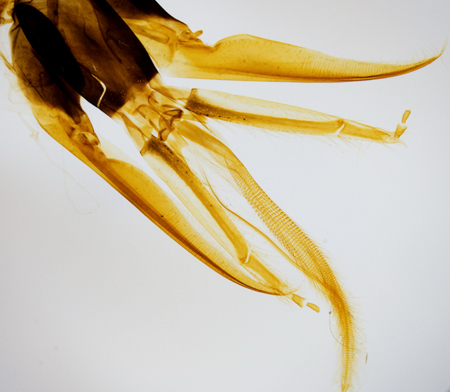
Bee Apis mouthparts, near full field of stereo, 2X optical mag, left EFCS off, right EFCS on. Residual vibration effects for heavily resized web images like these may not matter although, as here and have seen on other subjects, there is a subtle loss of micro contrast.
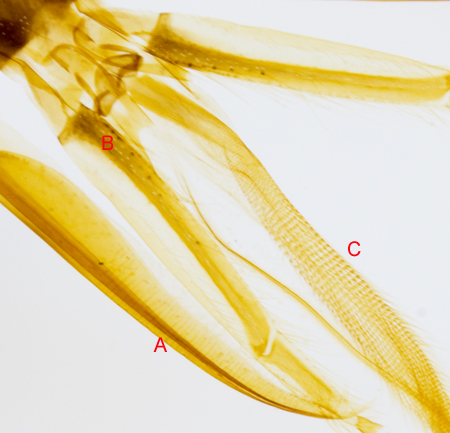
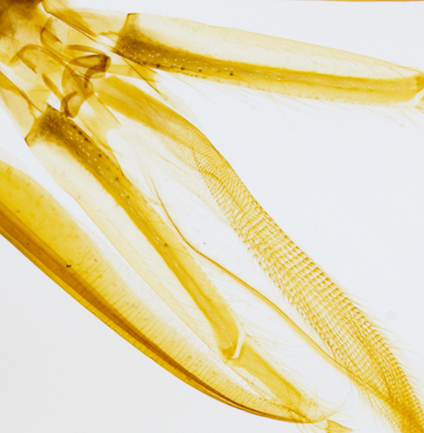
Images as above but crop of detail from master (left, EFCS off, right EFCS on), resized without sharpening. For images where crops are taken or for larger web images or prints, the residual vibration may be more obvious. This can be evident as a loss of fine detail and micro contrast i.e compare the transverse lines at A, the fine pale pores and dark spots at B and the complex detail at C.
It was this indefinable loss of detail in digital images taken with a Panasonic GF2 (without EFCS) cf what was seen visually, that first alerted me to check the system for vibration. I had assumed there would be no vibration problem from a mirrorless camera at low stereo mags.
Comments:
The NEX-5N EFCS option remains permanently enabled for photomicroscopy and gives essentially vibration free imagery allowing any shutter speeds to be used; this includes up to the maximum optical mag of 2500X on the Photomicroscope. The feature can't of course correct for any contributions from external vibrations e.g. building sourced or traffic / machinery which fortunately we don't experience. The very
firm coupling to the large mass Photomicroscope was not sufficient to suppress the shutter vibration without EFCS activated. Each user's setup is different of course and many users may well experience no vibration problems with a given mirrorless camera without EFCS.
For a mirrorless camera without EFCS, whether directly coupled or independently supported, it's worthwhile checking for vibration over a range of mags and shutter speeds as Zeiss recommended. An electronic flash to capture vibration free control images may be needed (see Footnote 2), especially if the camera does not have EFCS. As illustrated, if there is residual rather than gross vibration e.g. at lower mags and certain shutter speeds, its effects can be subtle and may just take the edge off sharpness and/or micro-contrast.
When previewing the live image on the NEX-5N LCD, a 10X zoom-in is available; the lightest touch in this mode can move the image slightly and a likely insight into why a lightweight shutter undergoing a double mechanical action on these mirrorless cameras at start of an exposure may have a marked effect even on a large microscope with sturdy, apparently flexless couplings.
Comments to the author David Walker are welcomed.
Acknowledgement: Thank you to my brother Ian for extended access to the Sony NEX-5N. My own camera is now a Canon 600D with fixed EFCS, but prefer the simpler NEX-5N setup and its wider capture field when carrying out stereo photomicroscopy.
Footnotes:
1) External camera supports: An external camera support is not a guaranteed solution and can create its own vibration problems if not correctly designed because the camera and microscope can potentially vibrate independently. This could be a particular concern if external vibration sources are a known problem. The external support needs to be very sturdy as does the microscope
support.
Some of the modern commercial camera supports such as macro / copying stands or enlarger stands designed for low power work may not offer the rigidity required for photomicroscopy and their bases can be awkward. Some of the older camera supports were very sturdy. M I (Spike) Walker in his excellent book 'Amateur Photomicrography' (Focal Press, 1971) has a valuable discussion on the pros and cons of external camera supports; the book offers much practical advice which remains relevant in this digital age.
2) Using electronic flash as a control for known vibration free images: Some cameras like the Sony NEX-5N have no hot shoe or flash fitted as standard. To add flash control images to the vibration studies, I waited until dark, then opened the camera shutter via self timer for ca 4 secs to allow the flash gun to be fired manually; either for incident light on the stereo scope or transmitted on the photomicroscope using a half silvered mirror at 45° on microscope base.
Published in the November 2012 edition of Micscape.
Please report any Web problems or offer general comments to the Micscape Editor .
Micscape is the on-line monthly magazine of the Microscopy UK web site at Microscopy-UK
©
Onview.net Ltd, Microscopy-UK, and all contributors 1995
onwards. All rights reserved.
Main site is at
www.microscopy-uk.org.uk.